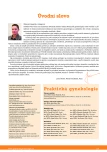Determination of oxidative stress-related surface damage to human sperm by atomic force microscopy.
Authors:
I. Crha; J. Přibyl; P. Skládal; J. Žáková; P. Ventruba; E. Lousová; M. Pohanka
Authors‘ workplace:
Gynekologicko–porodnická klinika LF MU a FN Brno
1; Národní centrum pro výzkum biomolekul, Přírodovědecká fakulta MU Brno
2
Published in:
Prakt Gyn 2010; 14(3): 120-122
Category:
Original Article
Overview
Aim of the study:
Oxidative stress is considered to be one of the important etiological factors of male fertility disorders. Excessive production of oxygen radicals results in damage to the sperm cell membrane and its DNA. The aim of the study was to apply atomic force microscopy (AFM) to depict surface damage to sperm exposed to experimental oxidative stress.
Material and methods:
Fresh samples of semen from sperm donors were obtained and processed. The AFM system Ntegra Vita (NT-MDT, Moscow, Russia) was used to characterize spermatozoa morphology within a nanometer scale. Surface topography and spatial distribution of electrical potential gradient on the sample surface were measured and recorded simultaneously, providing more complex understanding of the surface morphology. After the initial scanning and imaging of the normal spermatozoa, the slides were exposed to hydrogen peroxide solution (50 mmol/l) for 10 minutes, properly rinsed with distilled water, air dried and re-scanned. The defects were detected and recorded.
Results:
The obtained images clearly show both normal sperm head and defects of the surface of spermatozoa exposed to hydrogen peroxide. It was possible to even clearly distinguish the ultrastructure of the top of the flagella and the acrosome surface. Moreover, elements of internal structure can be observed whenever plasmatic membrane is missing. The best images of both normal and damaged spermatozoa were selected for presentation.
Conclusion:
Collected AFM images clearly highlighted many details of normal spermatozoa and spermatozoa damaged by hydrogen peroxide. This technique could represent an important tool when researching oxidative stress and explaining its effect on male infertility.
Key words:
spermatozoon – oxidative stress – AFM – infertility
Sources
1. WHO laboratory manual for the Exa-mination and processing of human semen. 5. ed. World Health Organization 2010, Ženeva: 271.
2. Zamboni L. The ultrastructural pathology of the spermatozoon as a cause of infertility: the role of electron microscopy in the evaluation of semen quality. Fertil Steril 1987; 48(5): 711–734.
3. Joshi N, Medina H, Colasante C. Ultrastructural investigation of human spermatozoon by using atomic force microscope. Arch Androl 2000; 44(1): 51–57.
4. Agarwal A, Prabakaran SA, Said T. Prevention of oxidative stress injury to sperm. J Androl 2005; 26(6): 654–660.
5. Crha I, Hrubá D, Fiala J et al. The results of infertility treatment by in-vitro fertilisation in smoking and non-smoking women. Cent Europ J Prev Med 2001; 9(2): 64–68.
6. Crha I, Kubesova J, Kralikova M et al. Homocysteine, folate and vitamin B12 in seminal plasma. Hum Reprod 2007; 22 (Suppl 1): 218.
7. Oborná I, Fingerová F, Hajdúch M et al. Lykopen v terapii mužské plodosti. Čes Gynek 2007; 72(5): 326–329.
8. Oborna I, Wojewodka G, De Sanctis JB et al. Increased lipid peroxidation and abnormal fatty acid profiles in seminal and blood plasma of normozoospermic males from infertile couples. Hum Reprod 2010; 25(2): 308–316.
9. Ierardi V, Niccolini A, Alderighi M et al. AFM Characterization of Rabbit Spermatozoa. Microsc Res Tech 2008; 71(7): 529–535
10. Joshi N, Medina H, Crúz I et al. Determination of the ultrastructural pathology of human sperm by atomic force microscopy. Fertil Steril 2001; 75(5): 961–965.
Labels
Paediatric gynaecology Gynaecology and obstetrics Reproduction medicineArticle was published in
Practical Gynecology

2010 Issue 3
Most read in this issue
- Borderline ovarian tumours
- Monozygotic twins in assisted reproduction treatment
- Elective single embryo transfer
- Cardiovascular disease in Turner syndrome, cardiovascular risks associated with pregnancy
